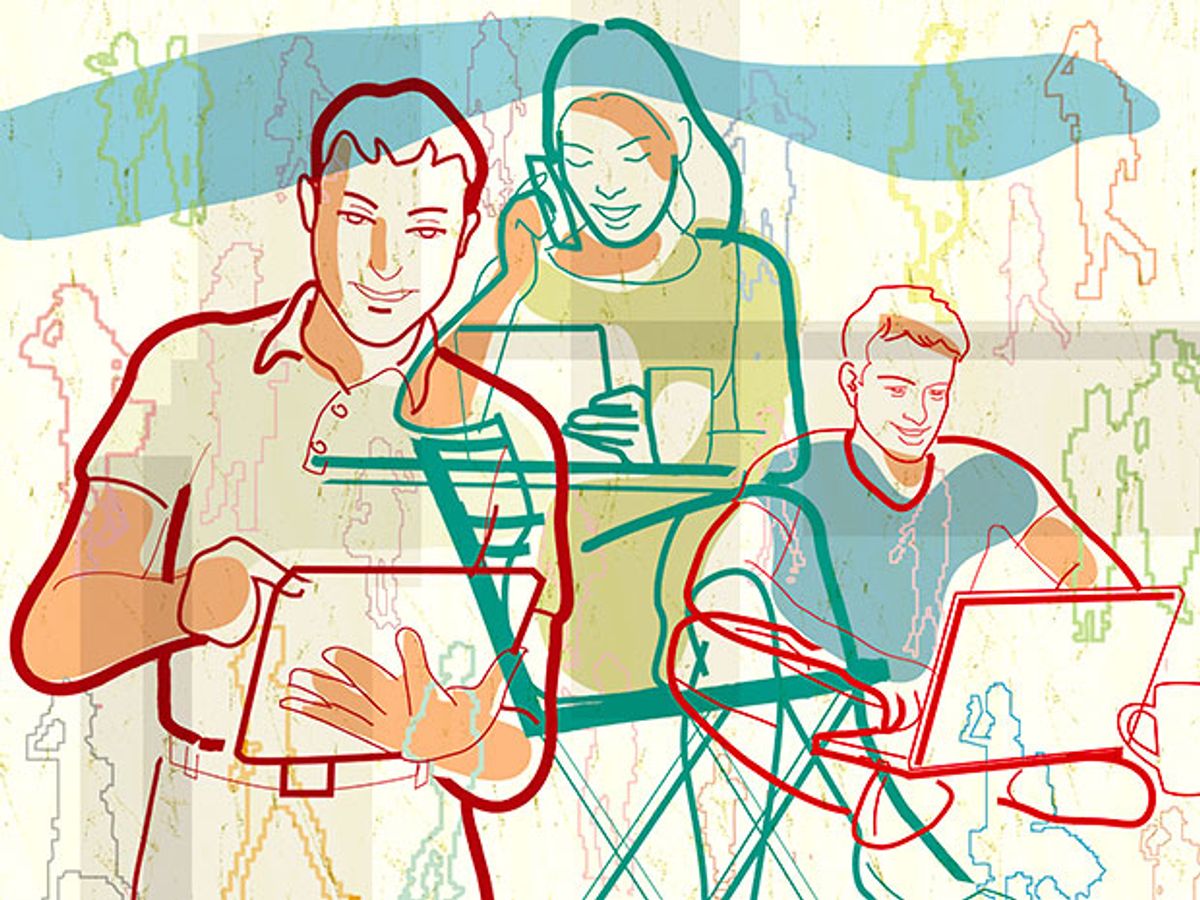With cellular networks slammed by increasing demand, mobile operators are hunting for extra radio waves to carry their customers’ wireless signals. One place they’ve set their sights on is an unlicensed patch of spectrum in the 5 GHz band that is primarily used for Wi-Fi. But mobile and Wi-Fi companies have quarreled for years about whether or not adding LTE users to these frequencies would interfere with Wi-Fi networks.
To remedy the situation, new research from Portugal’s Instituto de Telecomunicações describes a strategy that could help LTE and Wi-Fi users to get along: empower crowded Wi-Fi users to hop over to licensed LTE bands when space gets tight on the unlicensed channels. If this approach succeeds in real-life trials, it could help LTE-U overcome some of the political and technical hurdles it has faced since Qualcomm first proposed it in 2012.
The whole kerfuffle began when Qualcomm and cellular service providers including Verizon and T-Mobile argued that shifting some of their LTE traffic over to unlicensed spectrum during busy periods would add extra capacity to their growing networks, and help them provide better, faster coverage for customers. They called the extended network enabled by this strategy LTE-U, for its use of unlicensed spectrum.
But Wi-Fi and cable providers were not pleased, because this meant LTE users would directly compete for batches of unlicensed spectrum (particularly those at 5 GHz) that have traditionally delivered Wi-Fi. Opponents such as Google and the nonprofit Wi-Fi Alliance worried that adding LTE devices to the same frequencies would interfere with Wi-Fi users.
One reason for their concern is that Wi-Fi-enabled devices are programmed to share bandwidth with other devices that use the same router. These devices are “polite,” meaning they will throttle their owner’s consumption in order to fit another user onto the network, which is why Wi-Fi networks slow down as more people join.
Such chivalry would work against Wi-Fi users, though, if LTE customers suddenly began switching over to LTE-U and using the same unlicensed spectrum. The fear was that since LTE devices do not have any polite sharing mechanism in place, they would greedily claim bandwidth for themselves and leave courteous Wi-Fi users in the dust. The debate about exactly what this would mean for Wi-Fi users has been ongoing, but opponents generally believe it would cause long waiting times and lower throughput.
Faced with this dilemma, Shahid Mumtaz, a wireless researcher at the Instituto de Telecomunicações, developed an approach to help these two groups live in harmony. His technique allows Wi-Fi users to hop onto a licensed LTE band to send data when unlicensed channels become too busy. Mumtaz and his colleagues called it WiFi-Lic, for its use of licensed spectrum.
The group employed cognitive radio technology, which scans for any available spectrum that is not currently occupied by a user, to enable Wi-Fi users to search licensed LTE bands for free space every millisecond. Once a Wi-Fi user identifies a free space in the licensed band, they hop on and start using it. When they’re finished transferring data, or if they detect that a licensed LTE user needs the space, they hop back off.
The group carried out a simulation on the 5 GHz band to demonstrate how such a strategy would work, featuring 50 users who shared 10 Wi-Fi routers and a single 4G LTE base station. Each user was instructed to send a 0.5 MB data file multiple times in experiments that ran for several days.
In the end, the tests with WiFi-Lic achieved 160 percent more throughput than those without it and the waiting period for Wi-Fi users was essentially cut to zero. Based on these results, Mumtaz said he would expect any real-world network to roughly double its capacity by implementing WiFi-Lic.
However, Ravi Balakrishnan, a research scientist at Intel Labs who has worked with cognitive radio in the past but was not involved in this project, is skeptical. He says 1 millisecond (which also happens to be the duration of an LTE subframe, or scheduling period) seems like a very short amount of time for a Wi-Fi user to detect free space, communicate its plan to occupy that space, switch over to it, and transmit data.
“If you can do all of this within 1 millisecond, then you can do this, but I find it very challenging for the amount of hardware complexity that's required,” he says, adding that Wi-Fi users would, at the very least, need additional equipment—which would cost more.
Stefan Schwarz, who heads a wireless research lab at Vienna University of Technology in Austria, also points out that WiFi-Lic is only meant for Wi-Fi networks that are set up by an LTE operator, rather than home networks. And right now, it only works for data traffic—not for live streaming.
Mumtaz says he believes more Wi-Fi networks will be set up by LTE operators in the future, and he plans to further validate WiFi-Lic in a test bed this fall. It’s certainly a good time to be asking these questions: Earlier this year, Qualcomm received approval from the U.S. Federal Communications Commission to test its first pieces of LTE-U equipment. And LTE networks are not going to get any less crowded any time soon.



